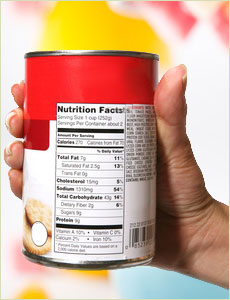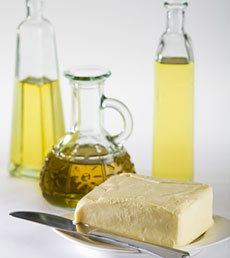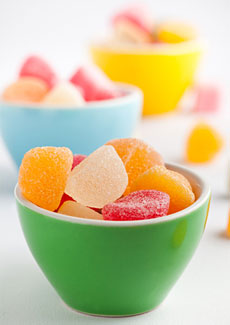Manufacturers' Tricks With Food Labels
The first trick up the sleeve of a food manufacturer is the very name of their product. When we see a product called apple and blueberry breakfast cereal, we automatically assume that apples and blueberries are among the key ingredients. In fact the name even conjures up images of juicy apples and tangy blueberries floating about in a bowl of wholesome cereal. However, the cruel reality is that our current FDA rules do not cover trademarks and product names, which means that your box of apple and blueberry breakfast cereal may contain just miniscule amounts of these ingredients. Be wary of food products with embellished names and instead concentrate on the ingredients list.
Almost every junk food in the market today is disguised as healthy food. Think about it, we all know that our markets are flooded with junk food, yet every single food product in the supermarket seems to champion health and fitness. Every food tin and every carton is labeled "Low fat" or even "fat free which creates the illusion of low calorie healthy food. Isn’t it strange that ever since these "healthy" foods became popular, obesity has reached pandemic proportions in our country? We even have foods that are labeled "Calorie free" which would lead you to believe that you could eat just about any amount of such a product without consuming a single calorie. So how do you navigate through this unscrupulous marketing? To make it a little simpler, here are some of the most common tricks with food labeling:

| 1. | Calories | First check the calories per serving. This will also tell you the breakup of the calories you consume - how many calories comes from fats and how much of it comes from carbs. |
| 2. | Serving size and the number of servings in the container | The serving size is EXTREMELY important as each manufacturer can decide what they consider to be a single serving of their product. This is often used to manipulate food labeling to make their product seem healthier than it actually is. For example, a manufacturer may claim that a single one of their cookies is one serving. If there is less than .5 grams of sugar in that serving, they can label it as a sugar-free product, even though the total box of cookies would definitely not be sugar-free. |
| 3. | Fat | Manufacturers may play a similar trick with the fat content in their products. There are some companies that go so far as to claim that one serving of a muffin is actually only 1/3 of the muffin. They can then make various health claims based on this serving size. |
| 4. | Sodium | The amount of sodium being added to packaged products has increased drastically in recent years. Check for the sodium content before you make your choice as increased sodium consumption has been linked to various serious health conditions. |
| 5. | Sugar | The various sugars are generally listed along with their quantities, but without a % Daily Value as there is no specific recommendation for sugar consumption. |
| 6. | % Daily Value (% DV) | This column tells you how much of a specific nutrient is present in a single serving of the food product in terms of your daily requirements. |
| 7. | Ingredient List | Ingredients are listed according to their proportion in the food product. The first three ingredients generally make up the bulk of the food but that does not mean that you should gloss over the others. Make sure that you check the entire list for sugar derivatives and other chemical additives. If the product is sweet and the sugar content is low, it is safe to assume that it contains sugar derivatives. |
- Fat free or no fat foods are those that have less than .5 grams of fat per serving.
- Low fat products are those that have no more than 3 grams of fat per serving.
- Lower fat or reduced fat food products contain 25 percent less fat as compared to the original product.
- Calorie free foods are those that have less than 5 calories per serving.
- Low calories food products contain 1/3 the calories of the original product.
- Sugar-free or sugarless products are those that contain less than .5 grams of sugar per serving. However, this only applies to sugar and not to sugar substitutes or sugar derivatives. In most cases, these sugar substitutes are even more harmful than sugar.
- Reduced sugar food products contain 25 percent less fat as compared to the original product.
- Salt free or no salt food products contain less than 5 mgs of sodium per serving.

- Lite or light can mean either that the product has less fat or fewer calories than its non-light version. However, these terms can even refer to the color of the product - generally in the case of syrups and other liquids. This means that you may be consuming a "lite" product that is just as unhealthy as the original, but you can rest assured that it is lighter in color!
- Catch phrases like "contains the goodness of" and "rich in" have absolutely no meaning and are just advertising gimmicks.
- The baked not fried marketing angle is always a great hit as it sounds healthier, never mind that the product may be just as unhealthy with just as much oil and fats!
- Common sense should dictate that a packaged food product cannot possibly be either "home-made" or "fresh"!

- Look for labels that read 'contains no preservatives' as these food products do not contain preservatives of any kind, either natural or artificial. However the product may still contain chemical coloring and flavors. Look for each individual additive and keep in mind that just because a food product does not contain one type of chemical additive, it does not mean that it does not contain the others. Food manufacturers never clump preservatives, colors, and additives together, and neither should you.
- 'No artificial colors or flavors' means that there are no artificial additives but the product may still contain "nature-identical" additives. A nature-identical additive is not obtained from a natural source but is prepared in a laboratory so that its chemical composition is identical to the flavor that is found in a natural product.
- MSG is one of those sneaky little ingredients that slip through the cracks. A food product label may state that there are no added flavors but it may still contain MSG. This is because MSG is listed as a flavor enhancer and not a flavor. No matter how it is classified, MSG is linked to a lot of health problems and should be avoided as far as possible.
- MSG is often disguised as yeast extract which sounds perfectly safe. Keep an eye out for the words hydrolyzed or autolyzed in an ingredient list as most of these ingredients contain hidden MSG.

- Our labeling laws prevent the use of the word healthy unless there is solid evidence to back up such a claim. Food manufacturers however manage to squeeze through the loophole when they use the word health as part of their registered trade name which makes their product seem like a good source of nutrition. Just because a product has the word health in it does not make it healthy. Remember, if your cereal tastes like cotton candy it's because its main ingredient is sugar not cereal!
- There is no legal definition for what exactly constitutes a natural food product and so just about any food can be labeled as natural. Since people are now health conscious, they automatically pick up a product that is labeled "natural". However, this product may contain an ingredient like hydrogenated oil which is definitely not natural, since hydrogenated oil is the result of forcing hydrogen gas into oil under very high pressure. This type of oil is known to increase bad cholesterol levels as well as decrease good cholesterol levels. So how is it that despite the dangers, this oil can still be one of the main ingredients in healthy "natural" foods like yogurt? Yogurt is often marketed as a tasty and natural slimming food but the truth is that the hydrogenated oil in it may actually cause weight gain among several other health problems.
- The term brown bread does not mean that the bread is necessarily made with wholegrain flour. Make sure that the flour product you wish to purchase is labeled "wholegrain "and not simply "brown". Many food giants use food coloring to give their white flour products the desired healthy brown color of wholegrain flour. This means that your loaf of brown bread may not contain additional nutrition, just additional chemicals from food coloring! This technique is also used with brown sugar and brown eggs.
- Many food manufacturers pad the ingredient list with herbs and healthy ingredients so that they can claim that their food product contains these ingredients. When a food product is marketed as a healthy food with a certain ingredient, check the ingredients label at the back to see where the ingredient appears. If it is towards the end of the list, it means that the food product contains just a smattering of the ingredient - enough to legally support their claims but not enough to make a difference to your health. This marketing trick is often used with various berries and spirulina.
- Some foods seem like they are absolutely brimming with nutrition and their nutrition labels seems to back the idea. The label will show impressive amounts of several vitamins and minerals and will show that a small serving of the food product will pretty much supply you with all the nutrition you require in a day. However, this does not make it a healthy food choice as you also need to check if it contains other not so healthy ingredients like partially hydrogenated oil, high fructose corn syrup, modified corn starch, and so on. Very often a kids' breakfast cereal box will highlight the fact that the child will receive a substantial amount of their daily nutritional requirements from a single serving of the cereal. However, it is important to note that the same serving will also contain several types of sugars and fats which pretty much negates the health benefits of the cereal. Some of the biggest brands of kids' breakfast cereal are extremely unhealthy with very high levels of salt and sugar. The levels of sugar in some kids' breakfast cereal boxes are so high that sugar is invariably the first or second ingredient on the ingredients label.
- Food manufacturers are required to list the ingredients in their food product according to the proportion in which they are present in the food. This means that the first item on the list is the most common or main ingredient of the product. One of the nastiest tricks of food manufacturers is to list down and distribute individual sugars. By doing this, food manufacturers ensure that the list of sugars appear lower down in the list and not right at the top , which is where they would be if they were combined. This is most commonly used in food products for kids; so, before you buy that so-called healthy fruit juice for your child, look for a list of ingredients like high-fructose corn syrup, brown sugar, and dextrose, sucrose, and corn syrup solids. Crazy as it sounds, your child's breakfast cereal may not be cornflakes with a small amount of sugar but sugar with a small amount of cornflakes!
- The distribution and isolation trick is also used to mask the total sodium content in a food product. Thus even if salt is at the bottom of the list of ingredients, look for yeast extract and soy sauce. Both of these ingredients are extremely high in their sodium content and this increases the total sodium content of the product.
| Name of the additive | Food products that contain the additive | Risks of consuming the additive |
| Sodium Nitrate/ Sodium Nitrite | Sodium nitrate is used in corned beef, packaged pork products, luncheon meats, smoked fish and other processed meats. | Sodium Nitrate has been linked to cancer in humans. |
| Potassium Bromate | Potassium Bromate is used in bread products to increase their volume. | Potassium Bromate has been identified as a carcinogen in animals. In fact, it is banned in almost every country, except for the US and Japan. |
| BHT and BHA | butylated hydroxytoluene (BHT) and Butylated hydroxyanisole (BHA) are used to preserve oils and prevent them from becoming rancid. They are generally used in vegetable oils as well as cereals and potato chips. | BHA and BHT research has shown that they cause cancer in rats. |
| Propyl Gallate | Propyl Gallate is also used to prevent oils from going rancid. It can also be found in meat products, potato chips, and chicken soup powder. | Propyl Gallate is suspected of causing cancer. |
| Acesulfame-K | Acesulfame-K is an artificial sweetener and is used in soft drinks, chewing gum, and baked food products. | Acesulfame-K research shows that there is a probability that it is a cancer causing agent. When it is broken down, it forms acetoacetamide which affects thyroid functioning in rats and rabbits. |
| Aspartame | Aspartame is an artificial sweetener that is often used in diet sodas and other diet foods. | Aspartame has been found to cause brain tumors in rats and even a small dose increased the incidence of leukemia in rats. |
| Olestra | Olestra is a synthetic fat that is used in potato chips and crackers. | Olestra can cause relatively minor problems like diarrhea and abdominal cramps but it also reduces the body's ability to absorb essential fat-soluble nutrients. |
| Hydrogenated vegetable oil | Hydrogenated vegetable oil can be found in cookies, bread, and salad dressings. | Hydrogenated vegetable oil contains trans fats which promote diabetes and heart disease. |
| Food colorings- Yellow 6, Red 3, Green 3, Blue 1 and 2 | Food colorings- Yellow 6, Red 3, Green 3, Blue 1 and 2 can be found in candy, beverages, and gelatin products. | These coloring agents have been linked to health problems such as brain tumors, kidney tumors, and cancer |